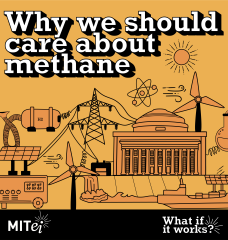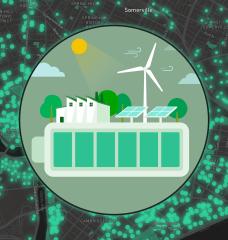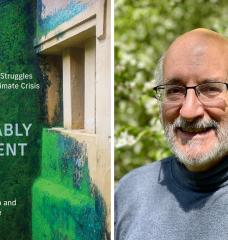
The Need for Decentralization
Universal access to sustainable energy is essential and central to nearly every major socio-economic challenges and opportunities, including jobs, safety, health, climate change, and food security. The Paris Agreement, which came into force on November 4, 2016, requires all parties to put forward their best efforts through “nationally determined contributions” (NDCs). This agreement is particularly is more important to harness the universal access to sustainable energy in the years ahead to reach the goal to limit global warming well below 2°C and as close to 1.5°C as possible. The International Energy Agency (IEA) estimates that energy use accounts for approximately 67% of total GHG emissions. Therefore, the Paris Agreement essentially demands a transformation to low carbon or zero carbon technologies in energy supply systems. This, in reality, however, is challenging to the developing countries, especially the least developed countries (LDCs), as they implement their plans in economic development, poverty reduction, and climate change mitigation and adaption.
Asia and Africa, particularly South Asia (SA) and Sub-Saharan Africa (SSA) are the regions with the most LDCs and home to the largest rural population, accounting for 3 of the 3.4 billion rural dwellers in the world (UNDESA 2015). The IEA (2016b) shows that there were approximately 1.2 billion people without electricity worldwide in 2015, 244 million (21%) in India alone and 632 million (53%) in SSA, which is defined as “energy access gap”. The United Nations estimates a rapid growth of rural population in the two continents in the next few decades – reaching over 1.2 billion by 2050. Rural electrification will thus be an increasingly critical issue for SA and SSA.
While there have been some important advancements in renewable energy development in developing countries, financial, technical and capacity barriers continue to hamper the efforts to provide universal energy access in SA and SSA. Alternative technologies, innovative business models, and new financial instruments for rural electrification must be applied to electrify the poor in SA and SSA. In this context, the promotion of a transformative pathway to sustainable development is required to initiate and implement decentralized renewable energy (DRE) in SA and SSA.
DRE is defined as on-site, off-grid, mini-grid or distributed energy systems that use renewable energy resources including small hydro, agriculture & forest biomass waste, wind, solar, and other new renewable energy resources. The outstanding characteristics of the use of DRE include local availability and no or low impact on both the local and global environment. Besides contributing to climate change mitigation and protecting natural capital, DRE is less vulnerable to the volatility of the fossil fuel markets that brings added benefits of stimulating local employment, technological development, and economic growth.
Challenges to Developing Decentralized Renewable Energy
Technologies alone, however, are not sufficient to provide the uninterrupted benefits of DRE. Rural electrification, coupled with mass scale DRE adoption, needs support from policy, capacity building, finance, and institutional development. There are instances when electric companies and energy suppliers defer expanding access to economically disadvantaged areas because such expansion is not believed to be financially and economically viable. In most developing countries in SA and SSA, the public sector could be stymied by its inability to implement or finance rural electrification projects and is always under pressure to satisfy other urgent public financing needs. In many instances, national planners may hesitate to promote on-site/off/mini-grid renewable energy projects because these technologies are thought to be relatively more expensive than fossil fuel-based energy technologies and the systems are normally sourced from overseas suppliers. In addition, government agencies give higher priority for expanding access to urban, rather than rural areas for a variety of socioeconomic and political reasons.
As the LDCs and developing countries in SA and SSA expand their economies and reduce poverty, they face major energy and climate change challenges, including the need to:
- Improving living conditions and enhancing economic opportunities to close the energy access gap.
- Reducing the adverse environmental effects and ancillary risks associated with current energy systems.
- Increasing energy security for all nations, regions, and communities, while at the same time reducing carbon emissions.
- Devising feasible financing models to reduce the high initial construction cost for accessing renewable energy, particularly for installing equipment.
Opportunities for Developing Decentralized Renewable Energy
Closing the energy access gap provides a huge business opportunity in the power sector. Although the per capita income in SA and SSA is about $2 per day on average, these people’s total income per day already amounts to $1.75 billion, or approximately $640 billion per annum. If 10-15% of the income is spent on energy at homes including lighting, cooking, and mobile phone charging, the energy market potential in SA and SSA amounts to $63-95 billion per year.
In the SSA countries, i.e., Tanzania, Kenya, and Uganda, there are a total of 15.5 million off-grid households. Each of these households spends approximately $200 per annum for energy-related services. These three countries provide a rural electrification market of $3.2 billion per annum. In addition, from 2017 to 2030 there will be a total of 250 million households in SSA that can hardly be electrified by the power grid, which provides a market of $50 billion per year for business in off-grid technologies.
Energy demand and supply patterns can be altered with the DRE development on a large scale. The productive use of DRE in rural areas helps raise incomes and improve health, as it provides power to pump water for irrigation, process crops, power cottage industries, and light homes, schools, and hospitals — all services of first importance and immeasurable impact in remote rural areas. These technologies, in reality, are more labor-intensive than conventional technologies for the same energy output — employing a mixture of local and international workers. For an investment in DRE technologies of $1 million over 10 years, wind energy generates 5.7 person-years of employment and solar photovoltaic (PV) generates 5.7 person-years, while the coal industry only generates 4.0 person-years (Pachauri 2009).
There are more opportunities on the innovation front. Lithium-ion batteries and super-efficient solar panels (30% efficiency vs. the present 21% or less) can redefine the use of solar rooftops. Similarly, solarizing energy-efficient appliances, aerogenerators, water pumping mills, and hybrid systems have reasonable potential with niche applications.
While demonstrating the cost and performance of new technologies is important, the followings are also necessary to harness the greater benefit in the long run:
- Improve government policies for creating markets conducive to DRE;
- Project investment is a necessary first step, but for success to be fully realized, catalyzing follow-on investments is also an important goal; and
- Complement intelligent investment with effective technology transfer for DRE technologies.
In this regard, a concerted effort is required from the national governments, the private sector, civil society organizations, local communities, and commercial banks to close the energy access gap by investing into the decentralized renewable energy.






